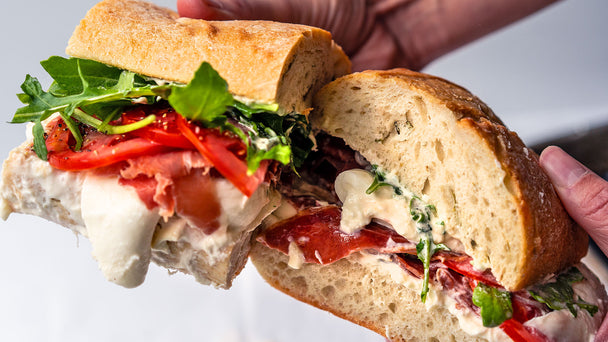It’s the essential decision that must be made almost every time you cook: Which oil should I use? If you’re like us, you probably come to an oil crossroads when you walk to the stove, eyeballing the variety of cooking oils in dark glass bottles lined up in an Instagram-worthy display on your granite countertop. Or maybe you’re the type who stashes their oil lineup in the pantry—that “cool, dry place” oil labels often encourage—ready to be tapped into service as the need arises.
Stop in any grocery store and you’ll see just a sliver of the vast oil types out there, from seed oils like sunflower and canola to classic vegetable oil. Among the premium oils, the “oil elite” as it were, olive oil and avocado oil reign supreme. These are the cooking oils you will often spot in food magazine spreads and on culinary TV shows where professional chefs and home cooks showcase the versatility of these essential pantry staples.
Olive oil and avocado oil do more than just prime your pan or grease a tray, although they’re helpful for that as well. Because olive oil and avocado oil have different flavor profiles, smoke points, origins, and uses, sometimes the entire character of a dish can change depending on the oil you choose. There are even recipes centered around the unique taste of a specific oil, such as olive oil cake or avocado oil vinaigrette. But if you’re whipping up a quick weeknight dinner, following a recipe that calls for oil, or trying something new, which oil should you reach for? Before we answer that question, let’s look at some similarities and differences between olive oil and avocado oil.

Where Does Avocado Oil and Olive Oil Come From?
The answer may seem obvious, but there’s more to these oils than you might think. A mainstay of Mediterranean cuisines, olive oil is produced by grinding black or green olives and extracting the oil through mechanical or chemical means. There are many varieties of olive oil, depending on factors such as the region where the olives are grown and the extraction process.
An olive oil is labeled “extra virgin” if extracted mechanically, such as by traditional pressing or centrifuge. Primal Kitchen® Organic Extra Virgin Olive Oil is cold extracted, meaning no heat is applied during the extraction process. Our Olive Oil is also certified for quality and purity by the NAOOA (North American Olive Oil Association).
Avocado oil is extracted from avocados, which originated in Central and South America. The avocado oil extraction process is similar to that of olive oil, with mechanical and chemical options.
Primal Kitchen Pure Avocado Oil is centrifuge-extracted without hexane, a chemical used in some oil processing. Though there’s currently no certification for avocado oil, we’re working with Codex Alimentarius (CODEX) to help determine an international specification for quality and purity. In addition, we evaluate certificates of analysis from suppliers to verify the purity of our oil so you know you’re getting the good stuff.
Primal Kitchen Pure Organic Avocado Oil offers all the benefits of our original avocado oil with the added advantage of USDA Organic certification. This ultra-premium oil is made from organic avocados grown in sunny Mexico and is also expeller-pressed without hexane.
Its neutral taste and high smoke point of around 500°F make it perfect for a wide variety of cooking methods from sautéing to air-frying and baking. Like our original avocado oil, it’s Non-GMO Project Verified and rigorously tested to ensure that only the highest quality oil makes it into each bottle. For those who prefer to eat organically, this delicious organic avocado oil is a must-have in the kitchen!
Nutrition Facts
Olive oil and avocado oil share similar amounts of calories and fat, with Primal Kitchen Avocado Oil being slightly lower in saturated fat than our Extra Virgin Olive Oil. Our pure avocado oil contains good fats from plant-based oil, with about 71% of the total fat content coming from monounsaturated fats. Here’s how our Avocado Oil and Extra Virgin Olive Oil break down in calories and fat per tablespoon.
|
Primal Kitchen Extra Virgin Olive Oil (1 Tbsp.) |
Primal Kitchen Avocado Oil (1 Tbsp.) |
|
|
Calories |
120 |
120 |
|
Total Fat |
14g |
14g |
|
– Saturated Fat |
2g |
1.5g |
|
– Monounsaturated Fat |
9g |
10g |
|
Carbs |
0g |
0g |
Taste & Texture: Avocado Oil vs. Olive Oil
Olive oil has long been a go-to for drizzling and dressing because of its distinct flavor and silky, buttery texture. Sharp and vegetal with a slightly detectable taste and aroma of green olive, it’s a flavor that makes you take notice.
Extra Virgin Olive Oil has a stronger taste than its more heavily refined counterparts (regular and virgin olive oils), with peppery notes and a touch of bitterness. Because the flavor is more potent than some other oils, like avocado oil, it is often used to balance the sweeter tomato notes in Italian and Mediterranean dishes.
Though avocado oil and olive oil have some similarities, their tastes are different. If you’re wondering whether avocado oil will have that earthy, grassy flavor that toast-loving millennials can’t get enough of, relax—it doesn’t. The taste of our Avocado Oil is best described as neutral and mild, with a slightly grassy undertone and a buttery, nutty texture.
While olive oil often has a strong green olive flavor, you might not be able to tell where avocado oil came from if you didn’t see the fleshy, pear-shaped fruit on the bottle. So save that big, bold flavor for that bowl of guac, and rest assured you’ll get a milder flavor from that drizzle of avo oil.
Smoke Point of Avocado Oil vs. Olive Oil
The smoke point of an oil is precisely what it sounds like—the temperature at which it begins to smoke. Besides giving your food that burnt flavor you’ve probably tasted when fries are overcooked in hot oil, the fats in the oil start to break down after the oil reaches its smoke point. That’s why paying attention to the smoke point when choosing an oil to cook with is important. For more details on why smoke points are important and how commonly used oils stack up against each other, check out our article on cooking oil smoke points.
Before you automatically reach for your oil of choice or one that’s handy, check that the smoke point is equal to or higher than the temperature you plan to cook at. According to the North American Olive Oil Association (NAOOA), the body that governs our olive oil’s certification for quality and purity, the smoke point of Extra Virgin Olive Oil varies between 350°F and 410°F depending on factors such as the oil’s origin and the level of processing. So, olive oil works for prepping your lower-heat omelet pan, but it wouldn’t be a great option for a fiery stir-fry.
Cue the entrance of avocado oil, which handles high heat like a champion. The smoke point of refined avocado oil is around 510-520°F, making it able to withstand a variety of low-, medium- and high-heat cooking methods. From deep-frying to roasting, baking, sautéing, and air-frying, many standard cooking methods use temperatures well within the limits of avocado oil.

Avocado Oil and Olive Oil Uses
Now that you have a pretty good handle on the pros and cons of avocado oil and olive oil, it’s time to put that knowledge to good use. That means firing up the grill, turning on the oven, lighting a burner, or grabbing your oil bottle and going to town with a quick drizzle. Maybe you’ll even turn on that toaster oven that’s been gathering dust since your air fryer moved in.
Whichever cooking method you end up with, there are endless recipes and uses for olive oil and avocado oil. As a general rule of thumb, recipes that call for a neutral flavor and high heat will pair best with avocado oil, while lower-heat recipes where the oil’s flavor shines through work better with olive oil. Here are just a few of your options:
Baking: BOTH
Have you ever tasted the moist crumb of an olive oil cake? How about an avocado oil brownie? Both olive oil and avocado oil can be used in baking, although you’ll want to veer toward the latter if you are baking at 350°F or above. Both oils add moisture and a touch of butteriness to baked goods like pastries, oven pancakes, cakes, or these keto-friendly lemon poppy seed muffins made with Primal Kitchen Avocado Oil.
Deep-Frying: AVOCADO
The best temperature for deep-frying is around 350-375°F, so you’ll want to ensure that your oil has a smoke point of at least 375°F. That puts avocado oil squarely in the winner’s circle for french fries, ranch fried chicken, and other deep-fried favorites.
Air Frying: BOTH
Ah, the air fryer… offering all the crisp, crunchy, flavorful goodness of deep-frying without the greasy splatter or using up your entire bottle of precious oil. Which oil you choose depends on what you’re cooking up. For foods like this air-fried guacamole recipe cooked closer to the fryer’s max temperature (typically about 400°F), you’ll want avocado oil. Otherwise, you may opt for olive oil for lower-temp dishes.
Pan-Searing and Sautéing: AVOCADO
To get that perfectly seared crust on a steak or salmon or deliciously crisp veggies, you’ll need to crank up the heat a bit. That’s why we reach for Primal Kitchen Avocado Oil whenever we sauté veggies or whip up a dish like these delicate, elevated Seared Scallops.
Roasting: AVOCADO
Whether you’re trying to put a crackling crust on that holiday turkey or you’re roasting a chicken with herbs for your weekly meal prep, avocado oil is the name of the game. Roasting typically occurs at temperatures above 400°F, so having a high-heat oil on hand is essential. Give this roasted leg of lamb recipe a try and see for yourself!
Drizzling and Dipping: OLIVE
For this one, you’ll likely want to pick up the olive oil because it’s more flavorful rather than neutral. Consider a classic like our mouthwatering Caprese Salad, which benefits from olive oil's buttery, earthy flavor. You can also add a touch of Primal Kitchen Balsamic Vinegar of Modena for added sweetness to compliment this easy recipe.
Stir-Fry: AVOCADO
Traditional stir-frying involves cooking meat, vegetables, and rice over intense heat for a short time. While you’re probably not blazing your wok at temperatures over 750°F like in many Chinese restaurants, even the lower temperature stir-frying at home requires significant heat. So, pass on the olive oil and opt for a coating of Primal Kitchen Avocado Oil Spray before you tackle a teriyaki shrimp stir-fry.
The Final Word: Avocado Oil or EVOO?
The bottom line when debating between avocado oil and extra virgin olive oil (EVOO) is that there are many similarities between the two oils and a few key differences. As mentioned earlier, both oils have similar nutritional profiles. So, if you’re debating between reaching for your trusty avocado oil or classic EVOO, it mainly comes down to taste and usage.
Because EVOO has a more robust flavor, you’ll want to grab it whenever you want the taste of your oil to stand out, for example, in a homemade salad dressing, a pasta dish, or drizzled on top of ice cream (yes, we swear that’s a thing in some regions of the world). If you’d prefer the other flavors in your dish shine, avocado oil should be your first choice.
Because it has a higher smoke point than EVOO, about 500°F+, our pure avocado oil is also the best option for high-heat cooking such as frying or baking. But really, why choose just one oil for your pantry or kitchen countertop? Cover all your culinary bases and keep both our rigorously tested Avocado Oil and our Extra Virgin Olive Oil certified by the NAOOA close at hand. That way, you’ll always have the perfect oil!






